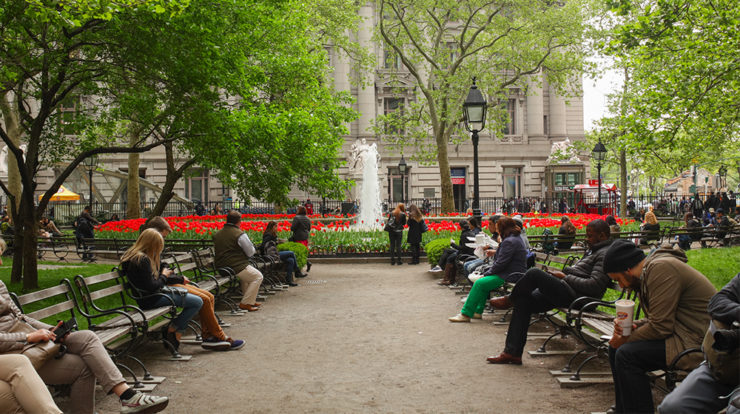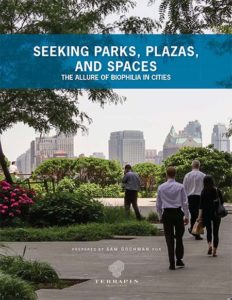

Project Profiles
Studying the Allure of Biophilia in Cities
Terrapin Bright Green
Share
Learn more about our biophilic design work and services by emailing us at [email protected] and reading our reports, 14 Patterns of Biophilic Design and The Economics of Biophilia. Follow the conversation on twitter: @TerrapinBG | #14Patterns.
By Sam Gochman
If you choose to take your lunch break outside rather than sitting at your desk, chances are you prefer a place that has nature or natural elements (pocket park, grassy lawn, views to water, etc.). Biophilia, our innate connection with nature, subconsciously steers us to places that allow us to experience nature and natural elements. This was the idea behind a new Terrapin Bright Green in-depth case study which examined the allure of biophilia in cities.
Connection with nature and the resulting benefits for wellbeing are ever-important in an urbanizing world. As the global population continues to leave rural settings for urban places, it is critical to avoid building places that lack nature. Stitching biophilic urban acupuncture into the urban fabric will help satisfy our inherent connection to nature by creating frequent access to nature in the urban environment.
76% of participants identified a biophilic feature as their favorite part of the space.”

View and download the full study: Seeking Parks, Plazas, and Spaces: The Allure of Biophilia in Cities – PDF (2 MB)
In this study, we surveyed 100 people on their lunch breaks at four sites—two biophilic and two non-biophilic—in lower Manhattan. These interviews indicated that participants walked a greater distance to biophilic sites, but most routes were short overall, suggesting that convenience is universally important. A large proportion of participants at biophilic sites liked at least one natural or “biophilic” element most about those spaces and cited both convenience and access to nature as the most important factors in choosing those spaces.
Surprisingly, at both biophilic and non-biophilic sites, most participants said that they would walk a longer distance to get to a space with more nature. It seems that people desire to be in nature during their lunch break, but that they opt for a more convenient location as the ultimate factor. Based on these results, we believe that planners, policy makers, developers, and community members should focus on the frequency and quality of urban biophilic interventions in order to maximize the opportunities for restorative and accessible biophilic experiences in the city. Let’s end the Sad Desk Lunch!
View and download all of the biophilic design case studies here.
 Sam Gochman is a Biophilic Design Intern at Terrapin Bright Green and is studying ecology, anthropology, and human-centered design at Dartmouth College. Having done work with biomimicry, he hopes to further explore the intersection of biology, human factors, design, and art. At Terrapin, Sam is investigating new ways to apply biophilic design and researching people’s attraction to spaces that connect with nature. Learn more about Sam at samgochman.com.
Sam Gochman is a Biophilic Design Intern at Terrapin Bright Green and is studying ecology, anthropology, and human-centered design at Dartmouth College. Having done work with biomimicry, he hopes to further explore the intersection of biology, human factors, design, and art. At Terrapin, Sam is investigating new ways to apply biophilic design and researching people’s attraction to spaces that connect with nature. Learn more about Sam at samgochman.com.
Topics
- Environmental Values
- Speaking
- LEED
- Terrapin Team
- Phoebe
- Community Development
- Greenbuild
- Technology
- Biophilic Design Interactive
- Catie Ryan
- Spanish
- Hebrew
- French
- Portuguese
- Publications
- Occupant Comfort
- Materials Science
- Conference
- Psychoacoustics
- Education
- Workshop
- Mass Timber
- Transit
- Carbon Strategy
- connection with natural materials
- interior design
- inspirational hero
- biophilia
- economics of biophilia
- Sustainability
- wood
- case studies
- Systems Integration
- Biophilic Design
- Commercial
- Net Zero
- Resorts & Hospitality
- Energy Utilization
- Water Management
- Corporations and Institutions
- Institutional
- Ecosystem Science
- Green Guidelines
- Profitability
- Climate Resiliency
- Health & Wellbeing
- Indoor Environmental Quality
- Building Performance
- Bioinspired Innovation
- Biodiversity
- Residential
- Master Planning
- Architects and Designers
- Developers and Building Owners
- Governments and NGOs
- Urban Design
- Product Development
- Original Research
- Manufacturing
- Industrial Ecology
- Resource Management
- Sustainability Plans
- Health Care
- Carbon Neutrality


